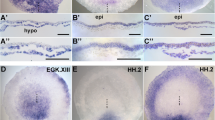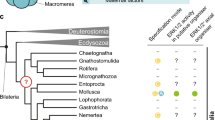Abstract.
During vertebrate neural tube formation, the initially lateral borders between the neural and epidermal ectoderm fuse to form the definitive dorsal region of the embryo, while the initially dorsally located notochord-floor plate complex is being internalised. Along the definitive dorso-ventral body axis, one can distinguish an epaxial (dorsal to the notochord) and a hypaxial (ventral to the notochord) body region. The mesodermal somites on both sides of the notochord and neural tube give rise to the trunk skeleton and skeletal muscle. Muscle forms from the somite-derived dermomyotomes and myotomes that elongate dorsally and ventrally. Based on gene expression patterns and comparative embryology, it is proposed here that the epaxial (dermo)myotome region in amniote embryos is subdivided into a dorsalmost and a centrally intercalated subregion. The intercalated subregion abuts to the hypaxial (dermo)myotome region that elongates ventrally via the hypaxial somitic bud. The dorsalmost subregion elongates towards the dorsal neural tube and is proposed to derive from an epaxial somitic bud. The dorsalmost and hypaxial somite derivatives share specific gene expression patterns which are distinct from those of the intercalated somite derivatives. The intercalated somite derivatives develop adaxially, i.e. at the level of the notochord-floor plate complex. Thus, the dorsalmost and intercalated (dermo)myotome subregions may be influenced preferentially by signals from the dorsal neural tube and from the notochord-floor plate complex, respectively. These (dermo)myotome subregions are sharply delimited from each other by molecular boundary markers, including Engrailed and Wnts. It thus appears that the molecular network that polarises borders in Drosophila and vertebrate embryogenesis is redeployed during subregionalisation of the (dermo)myotome. It is proposed here that cells within the amniote (dermo)myotome establish polarised borders with organising capacity, and that the epaxial somitic bud represents a mirror-image duplication of the hypaxial somitic bud along such a border. The resulting epaxial-intercalated/adaxial-hypaxial regionalisation of somite derivatives is conserved in vertebrates although the differentiation of sclerotome and myotome starts heterochronically in embryos of different vertebrate groups.
Similar content being viewed by others
Author information
Authors and Affiliations
Additional information
Electronic Publication
Rights and permissions
About this article
Cite this article
Spörle, R. Epaxial-adaxial-hypaxial regionalisation of the vertebrate somite: evidence for a somitic organiser and a mirror-image duplication. Dev Genes Evol 211, 198–217 (2001). https://doi.org/10.1007/s004270100139
Received:
Accepted:
Issue Date:
DOI: https://doi.org/10.1007/s004270100139




